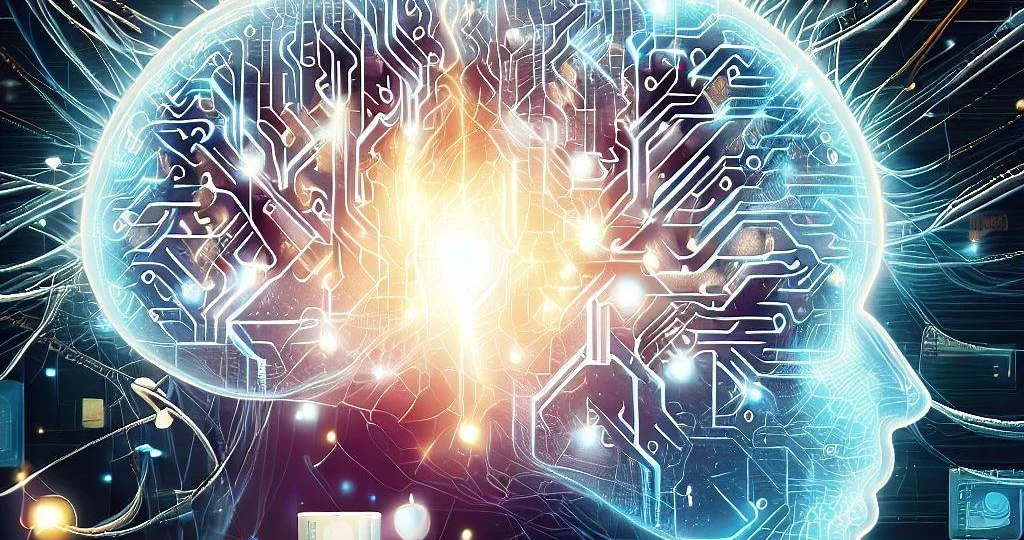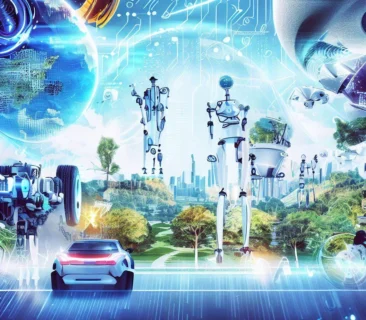Introduction:
In the ever-evolving realm of artificial intelligence, one paradigm has emerged as a transformative force, reshaping the landscape of technological innovation: deep learning. As we navigate the intricate tapestry of AI trends, “Impacts and Contributions of Deep Learning in AI Trends” stands as a spotlight on the monumental role deep learning plays in this dynamic ecosystem. Over the years, deep learning has transcended conventional boundaries, fueling groundbreaking advancements and revolutionizing industries. This exploration delves into the very fabric of deep learning, unraveling its profound impacts and far-reaching contributions, ultimately unveiling the threads that weave the fabric of our tech-driven future. Join us on this journey as we decipher the intricate tapestry of deep learning and its indelible influence on the course of AI trends.
Transformative Innovations
Deep learning’s journey through the realm of artificial intelligence has been marked by its remarkable ability to foster transformative innovations across diverse sectors. This keypoint unearths the profound impact of deep learning on shaping the trajectory of AI trends.
1. Unleashing Data’s Potential:
At the heart of deep learning lies its unrivaled capability to extract intricate patterns and insights from vast datasets. Traditional machine learning techniques often grappled with data’s complexity, but deep learning algorithms, particularly neural networks, have harnessed this complexity to drive unparalleled advancements.
2. Computer Vision Revolution:
Deep learning has propelled the field of computer vision into uncharted territories. From object detection and facial recognition to image segmentation and video analysis, convolutional neural networks (CNNs) have emerged as a cornerstone, enabling machines to perceive and understand visual information with human-like accuracy.
3. Voice and Speech Recognition Evolution:
Advancements in natural language processing (NLP) have birthed conversational AI systems that comprehend and respond to human language. Recurrent neural networks (RNNs) and transformer models have paved the way for virtual assistants and chatbots that interact seamlessly with users, offering personalized experiences.
4. Reinventing Healthcare Diagnostics:
Deep learning’s foray into healthcare has yielded transformative outcomes, from rapid disease detection to accurate medical imaging analysis. Convolutional neural networks excel in diagnosing medical images, while recurrent networks process time-series medical data for enhanced prognosis and treatment planning.
5. Autonomous Machines and Robotics:
Deep learning’s role in autonomous systems has redefined industries like automotive and robotics. Self-driving cars, drones, and industrial robots leverage deep learning algorithms for real-time decision-making, enabling machines to navigate complex environments autonomously.
6. Creative AI and Generative Models:
Deep learning has kindled the flames of creativity within AI. Generative adversarial networks (GANs) and variational autoencoders (VAEs) have given rise to AI-generated art, music, and even text, fostering novel modes of human-AI interaction and artistic expression.
The amalgamation of vast datasets, scalable computing power, and innovative algorithms has fueled deep learning’s ascendancy. Its ability to distill complex data into actionable insights, coupled with its adaptability to a spectrum of tasks, has brought about a technological renaissance. As industries embrace the transformative innovations catalyzed by deep learning, the contours of AI trends are forever altered, setting the stage for an era of unprecedented progress and discovery.
Enhanced Problem Solving
Within the intricate tapestry of artificial intelligence trends, the thread of enhanced problem-solving shines brightly as an integral contribution of deep learning. This keypoint delves into how deep learning algorithms tackle complex challenges, reshaping decision-making processes and accelerating progress.
1. Cognitive Processing at Scale:
Deep learning models excel at processing vast amounts of data, extracting intricate patterns that might remain hidden to traditional methods. By swiftly recognizing and analyzing complex relationships, these algorithms provide insights that drive informed decision-making across industries.
2. Pattern Recognition Unleashed:
The ability of deep learning systems to recognize patterns across diverse datasets has led to breakthroughs in various domains. From financial analysis to climate prediction, intricate correlations are unearthed, enabling experts to make data-driven choices with precision.
3. Dynamic Adaptation and Learning:
Deep learning’s self-adaptive nature allows models to evolve as new data becomes available. This dynamic learning capability is particularly vital in fields like cybersecurity, where patterns of threats and attacks are ever-changing, necessitating continuous model refinement.
4. Predictive Analytics Redefined:
Incorporating deep learning into predictive analytics has revolutionized forecasting. Whether it’s stock market trends or consumer behavior, neural networks adeptly process historical data, uncovering insights that form the basis for accurate predictions.
5. Personalized Recommendations and Marketing:
E-commerce and digital platforms leverage deep learning to provide personalized recommendations to users. By analyzing browsing history, purchase behavior, and preferences, algorithms tailor content, products, and services to individual users, enhancing user experience.
6. Real-time Decision-making:
Deep learning’s speed and accuracy empower real-time decision-making. This is evident in applications such as fraud detection, where systems analyze transactions in milliseconds, swiftly identifying anomalies and preventing potential financial risks.
7. Environmental Impact Assessment:
In environmental sciences, deep learning aids in assessing the impact of human activities on ecosystems. These algorithms analyze data from satellites, sensors, and simulations to model changes in climate, biodiversity, and land use.
8. Advancements in Drug Discovery:
Deep learning accelerates drug discovery by predicting the interactions between molecules and identifying potential drug candidates. This expedites the lengthy and resource-intensive process, offering hope for faster development of life-saving treatments.
The intricate interplay between data, algorithms, and problem-solving is where deep learning truly shines. Its ability to decipher complex relationships, adapt to changing scenarios, and empower decision-makers with actionable insights is revolutionizing industries and accelerating our technological journey. As deep learning continues to expand its reach, the weave of AI trends becomes richer, promising a future where complex challenges are met with innovative solutions.
Unleashing Creativity
In the dynamic landscape of AI trends, deep learning emerges not only as a tool for problem-solving but also as a catalyst for unprecedented creativity. This keypoint unravels how deep learning fuels creative tasks, such as art generation, music composition, and content creation, transcending traditional boundaries.
1. Artistic Ingenuity:
Generative models powered by deep learning, like GANs, have birthed a new era of AI-generated art. From paintings to sculptures, these models produce original creations, blurring the lines between human and machine creativity.
2. Musical Harmonization:
Deep learning’s prowess extends to the realm of music, with algorithms composing melodies, harmonies, and even entire pieces. This fusion of data-driven analysis and artistic expression redefines the creative process.
3. Creative Writing and Content Generation:
Language models fueled by deep learning are capable of generating coherent and contextually relevant text. They can craft articles, stories, and even poetry, showcasing a blend of computational understanding and linguistic finesse.
4. Design and Fashion Innovation:
Deep learning algorithms have entered the world of design and fashion, offering novel concepts and styles. From fabric patterns to architectural designs, AI’s contribution adds a fresh dimension to creative industries.
5. Film and Entertainment Enhancement:
Deep learning’s impact extends to filmmaking and entertainment, enhancing visual effects and rendering. AI-driven tools optimize rendering times and create realistic scenes, enhancing the overall cinematic experience.
6. Personalized User Interfaces:
User experience design benefits from deep learning’s ability to adapt interfaces based on user behavior and preferences. This level of personalization enriches interactions and tailors experiences to individual tastes.
7. Innovative Advertising Campaigns:
Deep learning’s insights into consumer behavior empower marketers to craft compelling campaigns. By analyzing consumer data, algorithms generate targeted content, enhancing engagement and conversion rates.
8. Cross-domain Creative Fusion:
Deep learning’s versatility enables the fusion of creative elements from different domains. It might combine visual art with music or blend literature with visual storytelling, leading to novel and captivating forms of expression.
The marriage of algorithms and creativity in the realm of AI trends transcends what was once deemed solely human territory. Deep learning not only expands the possibilities of artistic expression but also challenges preconceived notions of where imagination can flourish. As AI continues to stretch the boundaries of creativity, the symphony of human and machine innovation grows louder, composing a future where artistry knows no limits.
Autonomous Systems:
In the dynamic arena of AI trends, one of the most transformative impacts of deep learning lies in the realm of autonomous systems. This keypoint unveils the role of deep learning in powering self-driving cars, drones, and robotics, ushering in an era of intelligent automation.
1. Navigating the Roads:
Deep learning algorithms are the driving force behind self-driving cars. By processing real-time data from sensors, cameras, and LiDAR systems, these algorithms make split-second decisions, ensuring safe navigation and collision avoidance.
2. Skies of Autonomy:
Drones, whether for delivery, surveillance, or entertainment, rely on deep learning for autonomous flight. Machine vision allows drones to interpret their environment and avoid obstacles, making them versatile tools across industries.
3. Precision in Manufacturing:
Industrial robots armed with deep learning capabilities enhance manufacturing efficiency. These robots adapt to changing conditions, optimize production lines, and perform complex tasks with precision, minimizing errors and downtime.
4. Agriculture and Sustainability:
Deep learning finds its place in agriculture, where autonomous systems aid in crop monitoring, irrigation management, and yield prediction. By analyzing data from sensors and satellite imagery, these systems optimize resource usage and enhance productivity.
5. Healthcare and Assistance:
Robotic assistants equipped with deep learning algorithms support healthcare professionals. They can assist in surgeries, administer medications, and even provide companionship to patients, showcasing AI’s potential to revolutionize healthcare.
6. Oceanic Exploration:
Deep learning-enabled autonomous underwater vehicles (AUVs) unlock the mysteries of the deep oceans. These vehicles map underwater terrain, monitor marine life, and gather data on oceanic phenomena, contributing to scientific discovery.
7. Hazardous Environments:
Deep learning-powered robots are crucial in hazardous environments, such as nuclear reactors or disaster-stricken areas. These machines perform tasks humans cannot, ensuring safety while gathering critical information.
8. Future of Space Exploration:
Autonomous systems with deep learning capabilities hold promise for space exploration. From planetary rovers to autonomous spacecraft, AI-driven systems are advancing humanity’s reach into the cosmos.
The integration of deep learning into autonomous systems marks a paradigm shift in how machines interact with and navigate the world. These systems showcase the potential of AI to augment human capabilities and extend our reach into areas once deemed inaccessible. As AI’s role in autonomy continues to expand, the tapestry of AI trends weaves a narrative of progress, innovation, and the relentless pursuit of intelligent automation.
Natural Language Processing (NLP)
Within the intricate tapestry of AI trends, the thread of Natural Language Processing (NLP) stands out as a testament to deep learning’s transformative power. This keypoint delves into how deep learning’s contributions have propelled NLP to new heights, enabling machines to comprehend, generate, and interact with human language.
1. Language Understanding and Sentiment Analysis:
Deep learning models, particularly transformer-based architectures like BERT and GPT, have revolutionized language understanding. They grasp context, nuances, and sentiment in textual data, enabling applications like chatbots and sentiment analysis.
2. Translation and Multilingual Communication:
Deep learning’s ability to capture semantic relationships fosters advancements in machine translation. Neural machine translation models can decipher and translate languages with impressive accuracy, bridging global communication gaps.
3. Conversational AI and Chatbots:
Deep learning-powered chatbots engage users in natural, human-like conversations. They understand context, provide relevant responses, and adapt to users’ linguistic styles, enhancing customer support and user interaction.
4. Text Generation and Summarization:
Generative models rooted in deep learning can craft coherent text and summaries. These models find applications in content creation, news summarization, and even creative writing, showcasing AI’s linguistic finesse.
5. Contextual Understanding:
Deep learning enables NLP models to comprehend context in discourse, fostering more meaningful interactions. These models consider preceding dialogue, resulting in more relevant responses and smoother conversations.
6. Named Entity Recognition and Information Extraction:
Deep learning techniques excel at extracting entities and information from unstructured text. This aids in tasks like information retrieval, content categorization, and data extraction from documents.
7. Speech Recognition and Transcription:
Deep learning algorithms play a pivotal role in speech recognition systems. They convert spoken language into text, fueling applications like transcription services and voice assistants.
8. Accessibility and Inclusivity:
NLP, empowered by deep learning, enhances accessibility for individuals with disabilities. Speech-to-text and text-to-speech technologies enable seamless interaction and information consumption.
The fusion of deep learning with natural language processing has unlocked unprecedented possibilities for human-machine communication. As NLP models continue to evolve, blurring the lines between human and machine-generated text, the symphony of language becomes more harmonious, connecting diverse cultures, individuals, and ideas in ways previously unimagined.
Conclusion:
In the symphony of technological progress, the resounding notes of deep learning have woven a harmonious melody that resonates through the tapestry of AI trends. The impacts and contributions of deep learning are profound and far-reaching, touching every facet of our tech-driven era. From unraveling intricate patterns in data to redefining creative expression, from enabling autonomous systems to deciphering the nuances of human language, deep learning stands as a beacon of innovation, guiding us toward a future that was once the realm of science fiction.
As we navigate this landscape of possibilities, it’s crucial to recognize the ethical considerations that come hand in hand with the power of deep learning. Responsible AI usage, transparency, and ongoing research are imperative to harnessing its potential for the greater good. Just as deep learning empowers, it also demands our vigilance in ensuring that its impacts align with our values and aspirations.
The journey doesn’t end here. With each advancement in deep learning, the boundaries of what’s achievable in AI continue to expand. As we look ahead, we anticipate even more transformative breakthroughs, fueled by the ever-evolving synergy between deep learning and AI trends. From healthcare to space exploration, from creativity to autonomy, the story of deep learning is etched into the very fabric of our future, weaving a narrative of innovation, discovery, and progress that will shape generations to come.
References:
1. LeCun, Y., Bengio, Y., & Hinton, G. (2015). Deep learning. Nature, 521(7553), 436-444.
2. Goodfellow, I., Bengio, Y., Courville, A., & Bengio, Y. (2016). Deep Learning. MIT Press.
3. Karras, T., Aila, T., Laine, S., & Lehtinen, J. (2018). Progressive growing of GANs for improved quality, stability, and variation. arXiv preprint arXiv:1710.10196.
4. Vaswani, A., Shazeer, N., Parmar, N., Uszkoreit, J., Jones, L., Gomez, A. N., … & Polosukhin, I. (2017). Attention is all you need. In Advances in neural information processing systems (pp. 30-38).
5. Bojanowski, P., Grave, E., Joulin, A., Mikolov, T., Puhrsch, C., & Joulin, A. (2017). Enriching word vectors with subword information. Transactions of the Association for Computational Linguistics, 5, 135-146.




